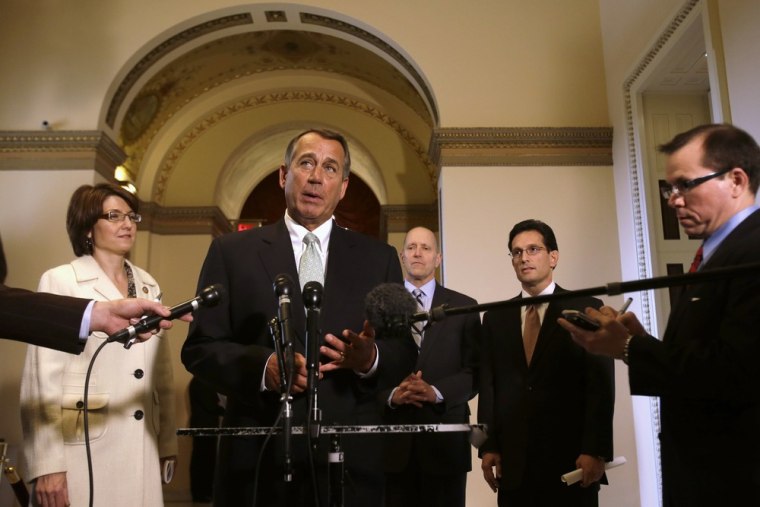
Next time you hear someone in Washington come up with a long-term plan to balance the federal budget, take it with a Capitol Building-sized grain of salt.
As the tax and spending battle rages on in the nation’s capital, Democrats and Republicans are vowing to replace temporary, stop-gap budget measures with a long-term plan to narrow the gap between how much the government raises in taxes and how much Congress agrees to spend.
Though bitterly divided over how to pull it off, both sides agree that a gradual, long-term, budget-balancing plan would do less damage to the economy than the steep, short-term spending cuts set to take effect in a few weeks. Earlier this week, House Republicans set a 10-year timetable for bringing revenues and spending into line.
"Balancing the budget over the next 10 years means that we save the future for our kids and our grandkids," House Speaker John Boehner, R-Ohio, said when the deal was announced.
Even if every member of Congress agreed with that goal, it’s a promise none of them can keep.
Any long term budget is subject to a long list of unknowns – from disasters and wars, to recessions and financial crises - that can quickly knock it off course. The list includes a future Congress that decides to tear up the plan and replace it with a new one.
“You can talk about a budget as a establishing a sense of direction but you can’t talk about a long term budget as a precise point of arrival,” said William Galston, a senior fellow at the Brookings Institution and a policy advisor in the Clinton administration. “All sorts of things can alter the assumptions that underlie any long-term planning.”
Congress hit the pause button in the ongoing budget battle this week) by delaying a looming deadline to prevent the government from borrowing to pay its bills. The deal lets the Treasury Department continue to sell bonds to make up the gap between the taxes it collects and the spending Congress has authorized.
That measure effectively postponed the debt ceiling crunch until mid-May. The exact date is difficult to predict because the Treasury is able to juggle its bills for a few weeks as it approaches the borrowing cap.
The next hard deadline comes with automatic budget cuts – the spending side of the so-called “fiscal cliff” – that were delayed until March 1 and pared down by $24 billion in the last-minute, year-end deal that raised taxes on the wealthiest households.
Those cuts, the so-called “sequester,” were enacted in July 2011 after the last debt-ceiling standoff.
The hope was that the impact of the cuts would be so dire that the deadline would force a compromise in the long-standing budget deadlock. Republicans and the White House remain on a collision course over a long-term plan to replace the sequester’s meat clever approach to spending cuts.
Both sides agreed to come up with a long-term budget plan – or forego their paychecks. (That’s another promise easier made than kept. The 27th Amendment requires that any change in elected representatives’ salaries apply only to the next session of Congress. So the move is largely for show.)
Replacing the short-term budget measures with a 10-year plan begins with a series of guesses about future spending that are all but impossible to make. Will the U.S. fight a war in the next decade? How many natural disasters like Superstorm Sandy will prompt emergency relief spending? Will the cost of health care continue rising faster than the rate of inflation?
There are even bigger wild guesses embedded in the economic projections used to estimate how much money the government will take in through taxes. Will there be a recession in the next 10 years? If so, will it be mild or severe? Short or long?
Like any long-term plan, a relatively small miss on that estimate can have a big impact down the road. If the current $16 trillion U.S. economy grows at the 50-year historical average pace of about 3 percent, for example, in 10 years gross domestic product – a rough measure of the nation’s income - will hit $21.5 trillion. If that growth rate continues at the current, roughly 2 percent pace, GDP will hit only $19.5 trillion – generating less tax revenue from businesses and households even if tax rates remain steady.
“You can solve a lot of problems if you simply build in the kind of economic performance that we saw in the last six years of Reagan or the last five of Bill Clinton,” said Galston. “It’s possible to do anything on paper if you don’t care what you’re doing.”